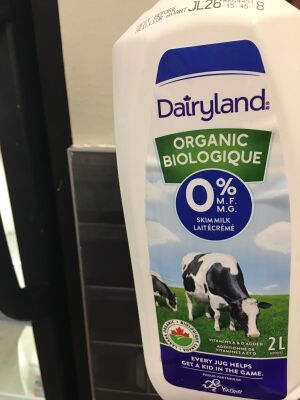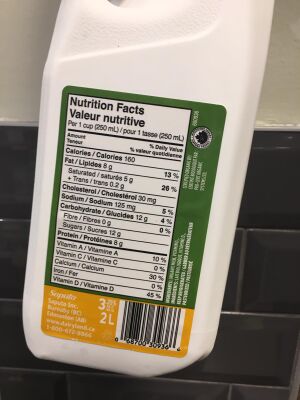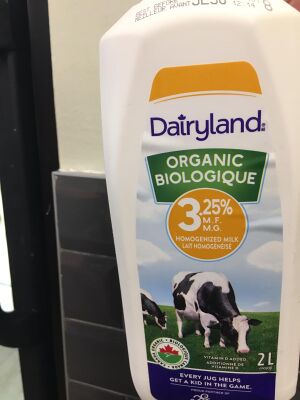Course:FNH200/Assignments/2021/Whole vs Skim Milk
One of the products is an organic whole milk with 3% fat, and the other is chocolate partly skimmed milk with 1% fat. Both products are milk products and are made by the same company ,'Dairyland'
Introduction
Milk and other dairy products are staple Canadian diet items.[1] In Canada, there is whole milk, partly skimmed milk, skimmed milk, lactose-free milk, organic milk, and many other types. This article analyzes the differences between Organic Whole Milk (3.25%) and Chocolate Partly Skimmed Milk (1%). With an increasing population in Canada, most would think that milk consumption has increased. However, according to Statistics Canada, the opposite has occurred. This is partially due to the declining availability of skim milk in Canada, which may have resulted from having a more diverse population where some people don't drink milk and there is high demand for healthier products. Additionally, many people drink milk alternatives instead such as almond and soy milk.
Milk is a staple food item due to its benefits. The antibodies found in milk help to strengthen our immune system, which will reduce the risk of many diseases. It is also rich in nutrients such as protein and calcium.[2]
Canadian milk is mainly produced in Ontario and Quebec. [1]




Ingredients
- Type out the lists of ingredients
- Identify fat substitutes, sugar substitutes, and/or additives used, if there is any
- Explain the roles of fat substitutes, sugar substitutes, and/or additives used in terms of the functional properties they contribute to the product
- Compare and contrast the lists of the two products and explain differences
| Dairyland Organic Homogenized Milk (3.25%) | Dairyland Chocolate Partly Skimmed Milk (1%) |
|---|---|
| Organic Milk | Partly Skimmed Milk |
| Vitamin D3 | Vitamin A Palmitate |
| Vitamin D3 | |
| Sugar | |
| Cocoa | |
| Caramel | |
| Salt | |
| Carrageenan | |
| Amaranth | |
| Artificial Flavour |
As seen in the above table, both types of milk contain added vitamin D3. However, the Chocolate Partly Skimmed Milk has also had vitamin A palmitate added to it because the vitamin A was lost from the milk when the fat was removed. Another difference between the ingredients of the two products is the type of milk. In the skim milk, the fat has been removed from the whole milk.
| Fat Substitutes | Sugar Substitutes | Additives | |
|---|---|---|---|
| Dairyland Organic Homogenzied Milk (3.25%) | n/a | n/a | n/a |
| Dairyland Chocolate Partly Skimmed Milk (1%) | n/a | n/a |
|
Neither of the two products contain any sugar substitutes nor fat substitutes. The Organic Homogenized Milk does not contain any added sugars or sweeteners, but the Chocolate Milk does have added sugar. In addition, the Chocolate Milk also includes cocoa, caramel, salt, carrageenan, amaranth, and artificial flavoring to enhance the product.
Carrageenan, Amaranth, and Caramel are all considered food additives in this beverage. Carrageenan is a commonly used thickener, emulsifier, and preservative extracted from edible red seaweeds. This substance helps to stabilize the chocolate milk by suspending the cocoa particles and creating a gel. Amaranth on the other hand, is a food coloring agent taken from the amaranth grain. It often has a reddish-brown appearance, and is therefore a suitable dye for the chocolate milk. Caramel is also used to color the milk. It is produced by heating up sugar, which creates a brown color.
Labels
- Provide detailed description of the information found on the labels
- Indicate whether the information complies with the regulatory requirements as outlined in Lesson 04.
| Necessary Labelling Requirements | Dairyland Organic Homogenized Milk (3.25%) | Dairyland Organic Skim Milk (0%) |
|---|---|---|
| Bilingual Labelling | Yes (English/French) | Yes (English/French) |
| Common Name | Homogenized Milk | Skim Milk |
| Storage Instructions | Keep refrigerated | Keep refrigerated |
| Country of Origin | Canada | Canada |
| Nutrional Facts | Per one cup (250ml): Calories: 160, Fat: 8g (13%), Saturated+ Trans: 26%, Cholesterol: 30mg, Sodium: 125mg, Carbohydrate: 12g, Fibre: 0g, Sugars: 12g, Protein: 8g, Vitamin A: 10%, Vitamin C: 0%, Calcium: 30%, Iron: 0%, Vitamin D: 45% | Per one cup (250ml): Calories: 90, Fat: 0g (0%), Saturated+ Trans: 0g (0%), Cholesterol: 5mg, Sodium: 125mg, Carbohydrate: 13g, Fibre: 0g, Sugars: 13g, Protein: 9g, Vitamin A: 10%, Vitamin C: 0%, Calcium: 30%, Iron: 0%, Vitamin D: 45% |
| Legibility and Location | The information is clear and legible | The information is clear and legible |
| Identify and Principle Place of Business | Dairyland, Edmonton AB, Burnaby BC | Dairyland, Edmonton AB, Burnaby BC |
| Date of Expiry | July 30, 2021 | July 26, 2021 |
| Irradiated Foods | n/a | n/a |
| List of Ingrediants | Organic milk, Vitamin D3 | Organic skim milk, Vitamin A palmitate, Vitamin D3 |
| Net Quantity of the food | 2L | 2L |
| Sweeteners | No added sweeteners (only naturally occurring lactose sugar is present) | No added sweeteners (only naturally occurring lactose sugar is present) |
| Other Mandatory information | Saturated | Saturated |
| Nutrient content claims | Vitamin D added | Vitamin A and D added |
Regulatory Requirements
According to Canada Justice Law, skim milk is approved when it contains equal or less than 0.3% milk fat, contains added Vitamin A with a reasonable daily in take of the milk between 1,200 and 2,500 international units, and contains Vitamin D with a reasonable daily intake of the milk between 300 and 400 international units. [3]
Based on the nutrition facts, Dairyland's skim milk follows the regulatory requirements as it has 0% milk fat. According to Dairyland's website, their skim milk contains no less than 1,200 IU of vitamin A and no less than 300 IU of vitamin D.[4]
Whole Milk shall be the normal lacteal secretion obtained from the mammary gland of the cow, genus Bos; and shall contain added vitamin D in such an amount that a reasonable daily intake of the milk contains not less than 300 International Units and not more than 400 International Units of vitamin D.
References
- ↑ 1.0 1.1 "Staple Foods". Canada Food Security. Retrieved 19 July 2021.
- ↑ "Milk". Wikipedia. Retrieved 19 July 2021.
- ↑ "Foods". Canada Justice Laws. 23 June 2021. Retrieved 19 July 2021.
- ↑ "Frequently Asked Questions". Dairyland. Retrieved 19 July 2021.
| This Food Science resource was created by Course:FNH200. |
